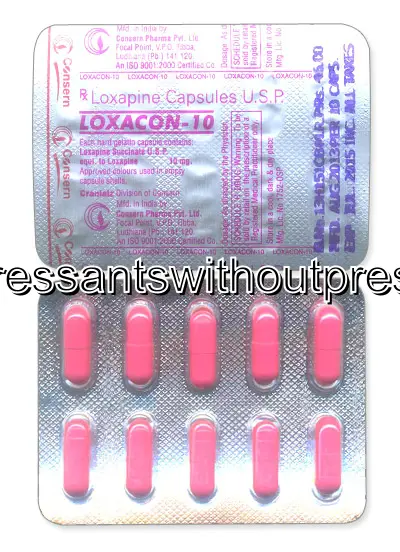| Package | Dosage | Price | Price per Dose | |
|---|---|---|---|---|
| Dosage: 10mg | ||||
| 360 pill | 10mg | NZD895.86 | NZD2.49 | |
| 180 pill | 10mg | NZD487.16 | NZD2.71 | |
| 120 pill | 10mg | NZD359.95 | NZD3.00 | |
| 90 pill | 10mg | NZD289.58 | NZD3.22 | |
| 60 pill | 10mg | NZD208.38 | NZD3.46 | |
| 30 pill | 10mg | NZD121.77 | NZD4.06 | |
| Dosage: 25mg | ||||
| 360 pill | 25mg | NZD1,277.49 | NZD3.55 | |
| 180 pill | 25mg | NZD717.22 | NZD3.98 | |
| 120 pill | 25mg | NZD541.29 | NZD4.52 | |
| 90 pill | 25mg | NZD441.15 | NZD4.90 | |
| 60 pill | 25mg | NZD322.06 | NZD5.36 | |
| 30 pill | 25mg | NZD189.44 | NZD6.31 | |

Loxapine Description
Overview of Loxapine
Loxapine is an antipsychotic medication primarily used to treat schizophrenia and other psychotic disorders. It belongs to the class of drugs known as typical antipsychotics, which work by affecting the balance of certain chemicals in the brain. Loxapine helps to reduce symptoms such as hallucinations, delusions, and disorganized thinking, enabling patients to manage their condition better.
How Loxapine Works
The medication acts on dopamine and serotonin receptors in the brain, blocking their activity. This action helps to correct the chemical imbalances associated with psychosis. Unlike some newer antipsychotics, loxapine has a broader spectrum of receptor activity, which can lead to both its therapeutic effects and potential side effects. Its mechanism helps to calm hyperactivity in the brain, alleviating symptoms of mental disturbance.
Administration and Dosage
Loxapine is typically administered orally in tablet form, but it may also be given via injections in certain cases. The dosage varies based on individual needs and response to treatment. Doctors usually start with a low dose and gradually increase it to minimize adverse effects. Patients should follow their healthcare provider’s instructions carefully and not adjust the dose without medical advice.
Benefits of Loxapine
Many patients experiencing schizophrenia find loxapine effective in controlling positive symptoms such as hallucinations and paranoid delusions. It is also valuable where other medications have been ineffective or poorly tolerated. Loxapine's fast onset of action can be beneficial in acute episodes where rapid symptom control is necessary.
Possible Side Effects
Like all medications, loxapine can cause side effects. Common issues include drowsiness, dry mouth, dizziness, and weight gain. Some patients might experience more severe reactions such as movement disorders, including tremors or rigidity. In rare cases, it can lead to tardive dyskinesia or worsening of symptoms. Monitoring by a healthcare professional is essential to detect and manage side effects promptly.
Precautions and Interactions
Patients with certain medical conditions, such as heart disease, liver problems, or a history of epilepsy, should inform their doctor before starting loxapine. It can interact with other medications, especially sedatives, other antipsychotics, or drugs that affect the heart rhythm. Combining loxapine with alcohol or certain recreational drugs should be avoided, as it can increase sedative effects or harm cardiovascular health.
Conclusion
Loxapine remains a valuable option for managing psychotic disorders. Its effectiveness and the rapidity with which it can control symptoms are significant advantages. However, careful supervision is necessary to mitigate potential side effects and interactions. As with any medication, adherence to prescribed instructions and regular medical check-ups are vital to ensure safe and successful treatment outcomes.
